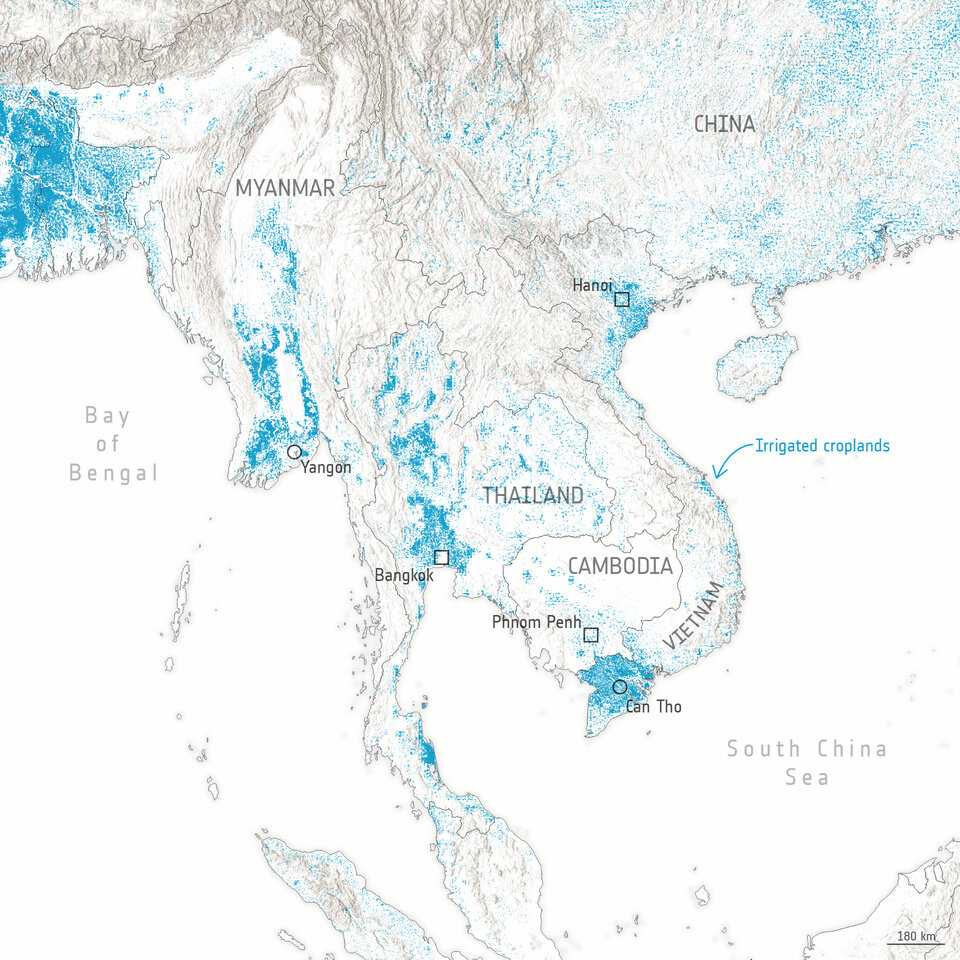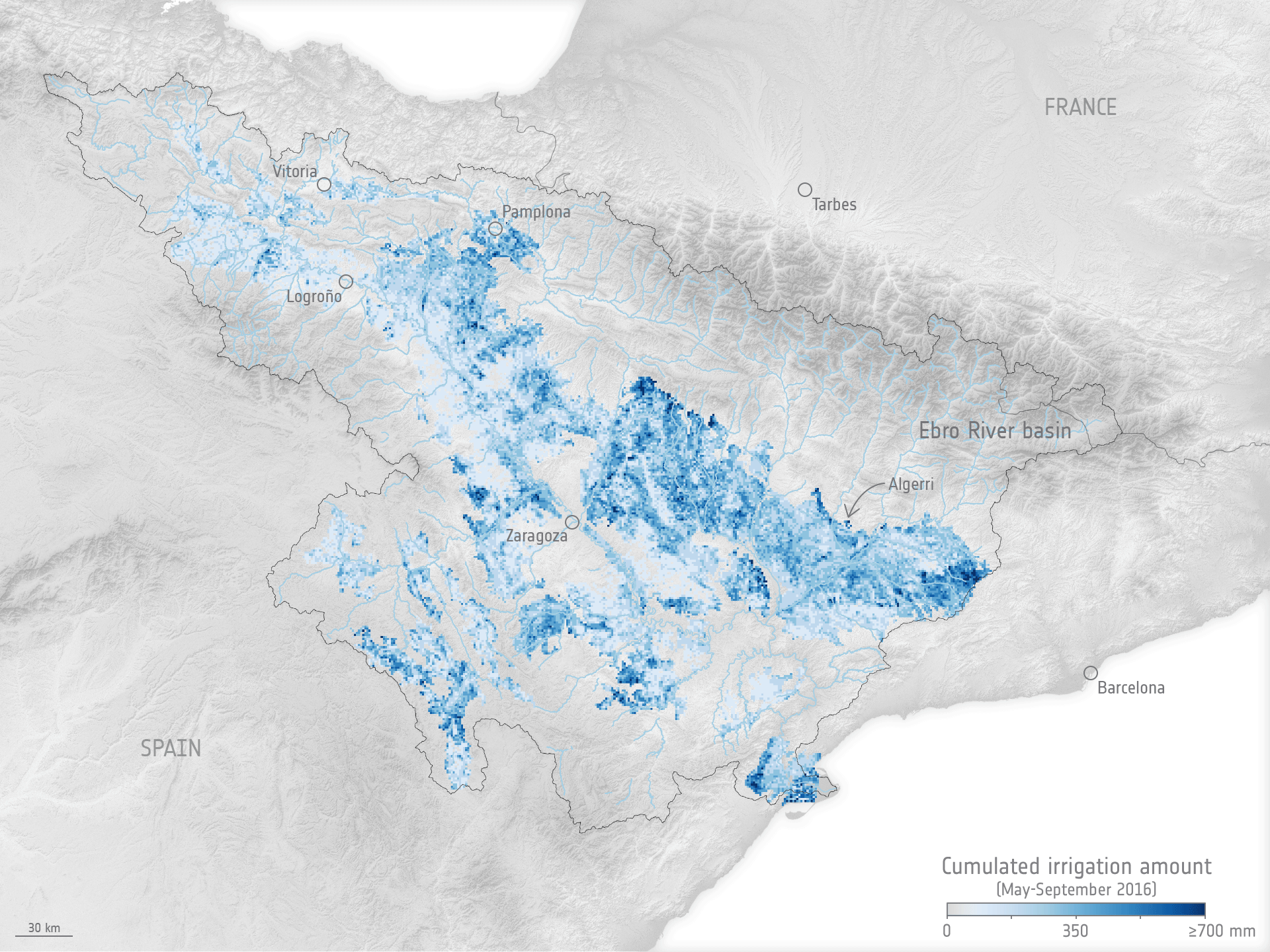Satellites unveil the far-reaching impact of irrigation
Globally, more than 70% of the freshwater withdrawn from Earth’s surface or from underground is used to irrigate crops. The need to produce more food for a growing population against the backdrop of climate change is challenging enough, but satellites reveal that extracting water doesn’t just affect the local environment – there are knock-on consequences for many aspects of the Earth system.
Irrigation is clearly essential for food production, enabling farmers to cultivate crops even in arid regions. In some circumstances, however, watering croplands can deplete surface water and groundwater reserves. This can result in local subsidence, saltwater intrusion and possibly alter biodiversity.
These local effects would be seen relatively quickly, but the wider consequences of irrigation practices have remained largely hidden, until now.
Thanks to a team of international scientists there is now a comprehensive description available of the complex interplay between irrigation and the global environment.
This new research, which was led by Sonali McDermid from New York University and supported by ESA’s Science for Society Irrigation+ project, was published recently in the Nature Reviews Earth & Environment journal.

Earth works as a delicate system and there is still much we don’t know about the intricate feedback mechanisms that drive natural processes. For example, there are many open questions about how the water cycle, the carbon cycle and Earth’s energy balance are interlinked.
Moreover, we have much to learn about how human activity is changing these processes, and, importantly, the wider implications for the planet as a whole.
It is estimated that worldwide around 2500 cubic kilometres of water is used for irrigation every year, which is more than is used for any other single purpose.
To put this into perspective, this is roughly the same amount of water that is in all the rivers in the world put together.
The images below of India show areas that are irrigated and the crops that are grown.


Open Image
In addition to the local impacts, the new research reveals, for example, that irrigation influences the surface energy balance and biogeochemical cycles.
During the growing season, irrigation can reduce the ground surface temperature by up to 3°C. While this may not come as a surprise, we all know that getting wet on a hot day cools you down and think of it as a good thing, it does exacerbate something called ‘wet heat stress’.
Wouter Dorigo, from TU Wien in Austria, explained, “Wet heat stress describes humidity. So, despite the ground being cooler after it’s been irrigated, the air is wetter – and we all know that we humans find it more difficult to cope with hot and humid conditions compared to hot and dry conditions.
“Humidity isn’t just confined to being a local effect, increased moisture levels in the atmosphere alter weather conditions and potentially affect rainfall patterns. These changes can have cascading effects on regional climates, potentially worsening droughts or causing unforeseen shifts in precipitation patterns.”


Open Image
Another consequence of irrigation is that while it boosts crop yield and enhances carbon uptake by the soil, extensive irrigation can also lead to increased methane fluxes through growing rice.
Methane is a very potent greenhouse gas that affects our global climate.
Christian Massari from Italy’s Research Institute for the Geo-Hydrological Protection, National Research Council, said, “Research that we’ve also carried out through ESA’s Irrigation+ project shows the potential for using different satellite systems to estimate irrigation. This could then help model numerous feedback loops linked to irrigation.”
Being able to monitor and assess the impact of irrigation on a global scale, offers valuable insights for farmers and decision-makers. Ultimately, this is crucial in guiding practices to mitigate the adverse effects of irrigation while promoting sustainable agricultural systems that support both human livelihoods and ecological well-being.















 Germany
Germany
 Austria
Austria
 Belgium
Belgium
 Denmark
Denmark
 Spain
Spain
 Estonia
Estonia
 Finland
Finland
 France
France
 Greece
Greece
 Hungary
Hungary
 Ireland
Ireland
 Italy
Italy
 Luxembourg
Luxembourg
 Norway
Norway
 The Netherlands
The Netherlands
 Poland
Poland
 Portugal
Portugal
 Czechia
Czechia
 Romania
Romania
 United Kingdom
United Kingdom
 Slovenia
Slovenia
 Sweden
Sweden
 Switzerland
Switzerland




































